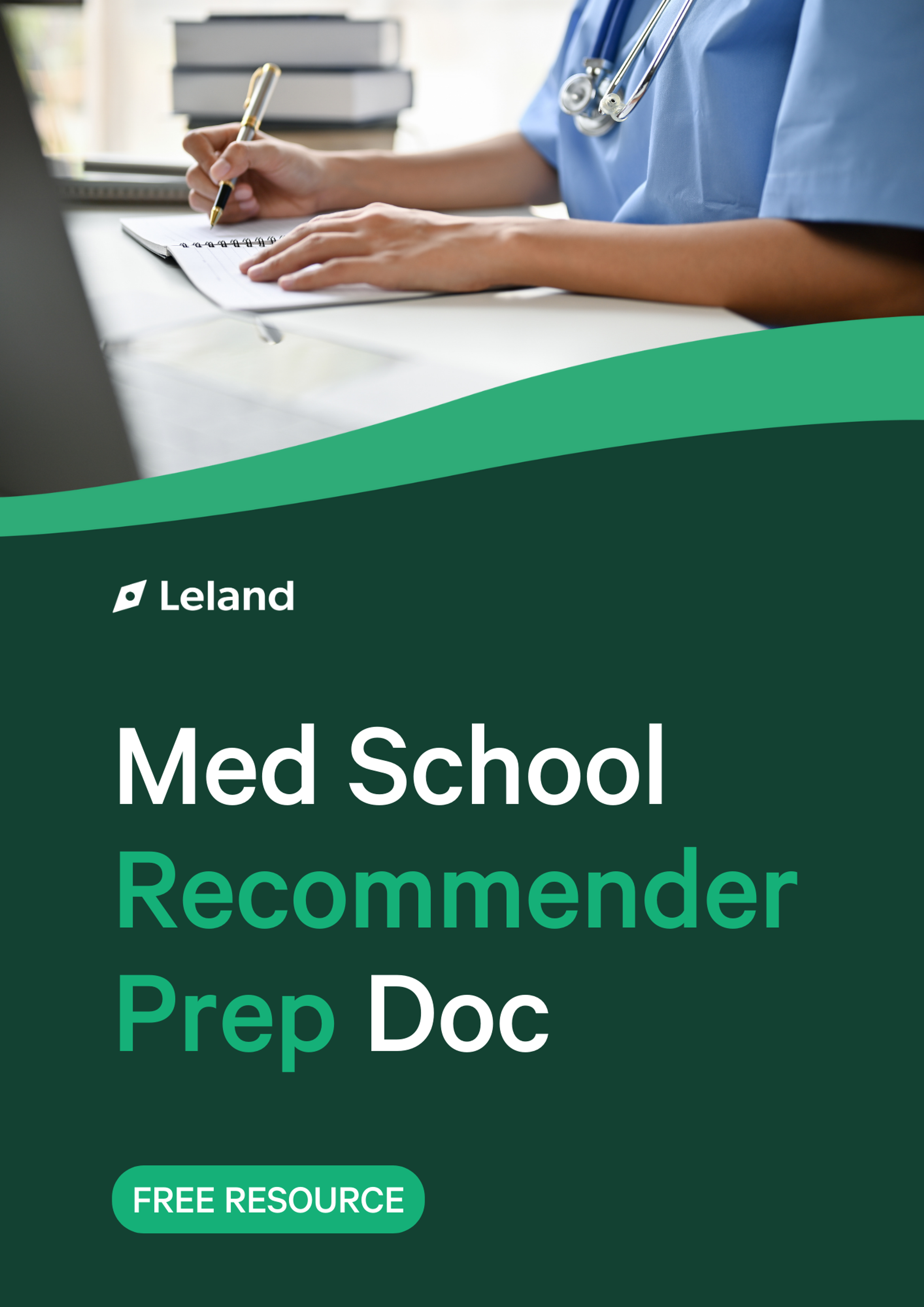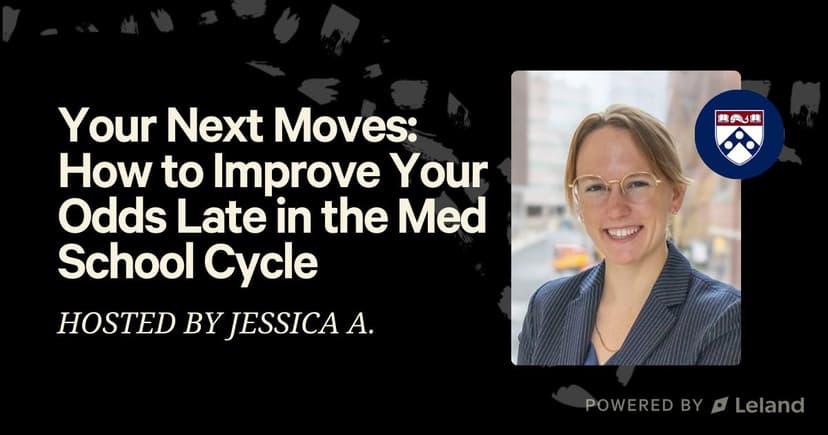The Ultimate Guide to the Medical School Application
Get a complete understanding of the med school application process– including the admissions requirements, pros and cons of applying, an overview of the timeline, and tips and get a downloadable checklist.
Posted June 16, 2025

Join a free event
Learn from top coaches and industry experts in live, interactive sessions you can join for free.
Table of Contents
The medical school application process is long, difficult, and highly competitive. Though the overall timeline varies drastically, the average age of most top programs’ applicants is around 24 years. However, the process begins long before that as applicants study for the MCAT, develop relationships with potential recommenders, acquire research experience, and more.
In this article, we’ll outline the benefits and downsides of applying to med school, the different parts of the application process, what’s required to apply, strategies for exam prep, and application tips. We’ll also provide you with a customizable med school application checklist, so you can make sure that you’re staying on top of the many moving pieces.
Pros and Cons of Medical School
The field of medicine is a difficult career trajectory because it requires years of graduate-level academic commitment before full-time work experience. Most MD programs involve four years of medical school, followed by three to five years of a residency training program. Following the residency, the MD candidate will need to get licensed and, eventually, take more exams to get board-certified.
The significant time commitment, as well as the level of difficulty, means that anyone considering going to medical school should seriously consider both its advantages and disadvantages. Here is a brief overview, but we recommend building on it based on your personal circumstances to decide whether medical school is the right path forward.
Pros
- Many work opportunities in a wide variety of areas – Clinically, MDs can work for hospitals, private practices, pharmaceutical companies, etc. However, there are many other non-clinical opportunities like teaching, government positions, research, and more. The demand for this job has historically remained high, and will likely continue to do so. Also, qualified doctors will not be able to just find a job in their home country, but around the world.
- Altruistic purpose – The demands of the job can be extreme but, at the end of the day, it involves healing people and improving lives. Very few professions can boast such an objectively positive mission.
- High compensation levels and relatively stable jobs – The average salary of doctors nationally is well over $200,000, with specialists earning much more than that. While pay levels should not be a primary motivation, they may play a role in the overall career decision. Also, as the majority of the population continues to age, doctors will only be more in demand.
Cons
- Long learning and training period – As mentioned, the 7+ years required before becoming fully licensed means that it will be a long time before you’re earning a full salary and working completely on the schedule and in the area that you want. This often prevents those more established in a career from transitioning into medicine but is not a complete barrier.
- Challenging work and environment – The nature of the job means very long hours, chaotic surroundings, and emotionally taxing work. Med school applicants should make sure that they are physically and mentally prepared for this. Also, both medical school and the actual work are academically difficult and require constant focus and lots of studying.
- Expensive education and licensing – With medical school, a lengthier degree process also means more substantial student loans. The average debt upon graduation is usually somewhere between $100-200K, and residency pay is notoriously low. Once that’s over, you can finally get licensed and if desired, board-certified. Licensing costs vary by state and range anywhere from $100 to $1,000. Unlike licenses, board certifications aren’t required to practice, but are still a pricey endeavor (test fees can cost upwards of 2,000).
The Medical School Application Process
Admissions Requirements
Now, let’s dive into what the application process and timeline actually look like for the average applicant. At a high level, in order to apply to medical school, you will need the following:
- A competitive MCAT score
- Resume
- Additional information (extracurriculars, etc.)
- Transcripts for all post-secondary education
- Letters of Evaluation/Recommendation
- Essay/personal statement responses
- Completed prerequisites
- Application fee(s)
- Letter of Intent (optional)
Almost every school has the applicant submit a preliminary application through AMCAS, the American Medical College Application Service. The caveat to this is if you are planning to apply/attend a medical school in Texas as most programs there use their own application service, TMDSAS. Both are centralized networks that are basically the equivalent of the Common App but for MD programs. After AMCAS/TMDSAS, most schools require that applicants fill out and submit a secondary, school-specific application; however, many of them extend that application by invitation only. If the applicant makes it through both rounds, they will then be invited to interview, after which the admissions decision is given.
Now, let's break down some of the more complicated application components.
MCAT Score
Your MCAT score is very important and serves as a critical benchmark for admissions committees in the application process. The higher the ranking of your target school, the better your score will need to be. To identify your score goals, make a list of the schools you're interested in applying to, and find the average MCAT score of the latest class. For example, Harvard Med reports an average of 520.59 for the class of 2027 — BBFL 130.24, CARS 129.08, CPBS 130.41, and PSBB 130.86. You want to at least hit the average of your target schools.
In general, the target score for different schools looks like the following.
- For top-tier institutions: 90th percentile or higher, typically around 515 to 528
- For mid-tier institutions: 80th to 89th percentiles, typically between between 508 and 514
- For less competitive institutions: 50th to 79th percentiles, typically in the range of 500 to 507
Resume
Not all schools require a resume as part of the application, but having one is never a bad idea. A well-structured resume not only highlights an applicant's educational background and relevant experiences but also showcases their commitment to the medical field. Many applicants will also bring one into the interviews. Detail any academic achievements, research experiences, volunteer work, and clinical exposures and include precise metrics and outcomes whenever possible.
- Quantify to put achievements in context
- Focus on impact - show that you made a difference in your various experiences
- Keep it to one page (generally)
- Emphasize academic excellence - this matters for medical school
- Highlight research experience and publications
- Don't add fluff - every line on the resume should matter
Letters of Evaluation
Letters of Evaluation or Recommendation are very important for medical school applications because they provide a different kind of perspective. Every other part of the application comes from the candidate themself; the letters provide an outside, third-party perspective, and it's important that it's a great one. A strong letter of evaluation should not only affirm your academic credentials but also provide detailed examples of your personal qualities and contributions to the community or research projects. It should make a very clear case for why you will not only survive but thrive throughout medical school and a medical career.
There are two important steps to obtaining excellent letters of evaluation:
- Choose wisely: Your recommenders should be people who are willing to be staunch advocates, someone you can draft to your "team." If you're not sure who to ask, have a discussion with the potential evaluators. Raise the topic of having them write the letter, and gauge their response. Their level of excitement is usually a good indicator of the quality of the letter you'll receive.
- Some schools offer a Committee Letter that you'll submit instead of individual letters. If your school offers one, make sure to build relationships with the committee as early on as possible.
- Prepare adequately: A lot of people think that all you need to do is ask your recommender to write the letter and then wait for it to show up. You can do this, but a much more effective method of preparation is to use an Evaluator/Recommender Prep Doc. This is a document that you would provide to your recommenders, ahead of when they actually start writing, that provides some anecdotes of your time working with them, an overview of your approach/narrative, and your personal statement draft (if you have one). Using this aligns your story across the different parts of the application and ensures that the recommender has good fodder for their letter.

Medical School Recommender Prep Doc
Download a free recommender prep doc with a template and example to ensure you're getting the strongest possible letters of evaluation
Here are the different kinds of letters of evaluation you may run into.
Committee Letter:
- A comprehensive evaluation is typically compiled by a pre-health advisor or committee at the applicant's undergraduate institution.
- Represents a holistic assessment of the candidate, combining input from multiple faculty members who have interacted with the applicant.
- Often includes a summary of the applicant’s academic and extracurricular achievements, character, and potential in the field of medicine.
Individual Letter:
- Written by a single recommender who can provide detailed insights into the applicant’s abilities and characteristics.
- Ideal recommenders are professors, research supervisors, or professionals in healthcare who have directly observed the applicant's work and conduct.
- Should provide specific examples of the applicant's skills, accomplishments, and personal qualities.
Letter Packet:
- A collection of individual letters which is assembled and sent by the applicant’s school.
- May or may not include a cover letter from a pre-health advisor or committee.
- Allows for a diverse presentation of the applicant from multiple perspectives, covering academic, research, and clinical experiences.
Composite Letter:
- Similar to a committee letter, but includes direct quotes or excerpts from individual letters.
- Compiled by a pre-health advisor or committee, providing a synthesized overview of the applicant’s qualifications.
- Offers a balanced view by highlighting key strengths and endorsements from various interactions and experiences.
Personal Statement
The personal statement is a cornerstone of the medical school application, offering candidates the opportunity to communicate directly with the admissions committees. This narrative essay should articulate why you are drawn to the medical field, how your background has prepared you for a career in healthcare, and what you hope to achieve as a future physician. Applicants should use their personal statement to weave together their academic achievements, clinical experiences, and personal challenges into a cohesive story that highlights their resilience, empathy, and commitment to medicine. A compelling personal statement not only distinguishes you from other candidates but also provides insight into your personality and values.
Here are some of our top tips:
- Start Early and Reflect: Begin well in advance of deadlines to allow ample time for reflection on your motivations and experiences in the field of medicine.
- Put the Personal in Personal Statement: Write honestly about your experiences and motivations, and dig deep. AdComs are admitting a person, not a list of accomplishments. They want to know that you have what it takes to succeed and are properly motivated to do so.
- Show, Don’t Tell: Use specific examples to demonstrate your qualities and skills rather than simply asserting them. Describe situations that illustrate your commitment, empathy, leadership, and resilience.
- Link Your Past to Your Future: Connect your previous experiences to your future goals in medicine, demonstrating continuity in your career trajectory. There should be a clear line of "this is why I did what I did, throughout the major decision points in my life."
- Get Feedback: Share drafts with mentors, advisors, or coaches. Fresh eyes can offer valuable perspectives and catch errors you might have overlooked. Ask reviewers, "What are the main takeaways from the personal statement? What stood out to you?" If they answer in line with your theme and narrative, you're on the right track.
Application Timeline
Prospective MD students will need to start thinking about the application long before they actually begin applying. We’ve outlined the different steps under both ideal and possible timelines below. As a quick note, though the AMCAS application is technically open from May/June through October/December, it’s highly recommended that you apply as soon as possible in that window. If you’re not able to apply until August (or later), it might be worth holding off until next year’s application cycle. Applying late significantly reduces your chances of admission.
Ideal Timeline
<3 Years Before AMCAS Deadline (~June)
- Start studying for the MCAT
- Develop relationships with potential recommenders; if your school has a premedical committee, start building a rapport with its advisers
- Complete prerequisite courses
- Gain research experience
- Get good grades
- Take the MCAT (some students choose to do this during the junior year of their undergrad, right after completing the prerequisite courses, as MCAT scores are valid for three years)
- Start thinking about target schools
3-6 Months to AMCAS Deadline (January-April)
- Take the MCAT (if you haven’t already)
- Brainstorm and reach out to recommenders
- Brainstorm, outline, and begin to draft personal statements
- Decide which schools to apply to
1 Month to AMCAS Deadline (May)
- Check in with recommenders
- Polish personal statements/essays
- Fill out AMCAS–background information, coursework, work/activities, designated medical schools, standardized test scores, etc.
June-July
- Submit AMCAS
- Receive and start completing secondary applications
- Prepare for interviews
August-September
- Interview
- Make any necessary updates to your application (address changes, new MCAT test date, letter of evaluation submissions, etc.)
October-November
- Receive the application decision
- If admitted, choose to accept/decline the offer
- Start researching and applying for financial aid, grants, and other scholarships
Possible Timeline
>April
- Study for the MCAT
- Complete any missing prerequisites
April-September
- Take the MCAT
- Reach out to recommenders
- Brainstorm/draft personal statement responses
September-November/December
- Submit AMCAS
- Begin working on secondary applications
- Submit secondary applications
January-March
- Interview
- Receive admissions decisions
As you can see, the timeline is quite broad depending on your circumstances and time restrictions. Give yourself as much time as you can–in the case of medical school applications, the longer you have, the better. However, if you are rushed and need to apply in a certain year, it is possible to get the application in on time.
Med School Application FAQs
1. How important is the MCAT exam in the medical school application process?
MCAT scores are extremely important and play a major role in admissions decisions. Because medical school is so academically rigorous, standardized test scores and GPAs are the main indicators that a student will be able to successfully navigate the challenging curriculum. Often, if an applicant with great work experience, a competitive GPA, an interesting story, and good letters of evaluation doesn’t get in, it’s due to a lower-than-average MCAT score.
2. How important is a strong personal statement in the medical school admissions process?
The personal statement essay is also very important. Most of the other parts of the application are just a blur of data; the personal comment section, on the other hand, is the one place where the applicant can make their candidacy personal. We recommend taking as much time as necessary to brainstorm the narrative, go through several drafts with the help of a coach, and polish it until you feel like it’s the best it can be.
3. How many letters of recommendation should I include in my medical school application?
The AMCAS permits ten letters of evaluation. Most schools have stricter limits, however, and may also restrict the kind of letters. Here is the maximum number of letters of recommendation allowed for the top 10 medical schools:
- Harvard: 6 (may exceed if the additional ones are from research supervisors)
- At least two from professors in the sciences
- At least one from a professor not in the sciences
- Committee letters are counted as one toward the maximum
- New York University: 10
- Requires a committee letter or a minimum of three individual letters, two of which must come from science professors
- Columbia University: 7
- Requires a minimum of three, one of which must come from a science faculty member, teacher, or research mentor
- Johns Hopkins University: 3 or a committee letter
- If you send the three individual letters, two must come from a non-science faculty member and one from a science faculty member
- You can send additional letters but they will not give you an advantage over the required three
- University of California–San Francisco: 5
- Must submit a minimum of three, including two from instructors
- Duke University: 6
- Requires four, two from science faulty
- Also beneficial to have a clinical letter addressing your ability to work with others
- A committee letter takes the place of the four letters
- University of Pennsylvania: 10
- Minimum of three individual letters or a committee letter (preferred)
- If individual letters, one must come from a science faculty who you’ve taken a class from
- Stanford University: 6
- Minimum of three letters; if a committee letter is submitted, only the individual letters within that will count toward the number of letters of recommendation
- The school recommends that applicants choose recommenders who can attest to their: leadership, originality, creativity, innovation, research skills and independence, clinical exposures and caring experiences, cultural humility, and social justice/advocacy
- University of Washington: 6 individual letters or a committee letter and 3 additional individual letters
- Minimum of three individual letters
- UW recommends that the collection of letters provide a balanced and well-rounded view of your candidacy
- Yale University: 1 committee letter
- If your school doesn’t offer a premedical committee, you’ll need to submit at least three individual letters, two of which should be from individuals in science fields
4. What is the interview process like for medical school admissions?
Interview invitations are sent out after the secondary application has been submitted, usually on a rolling basis. The interview process differs depending on the school. Generally, there are four different types of interviews:
- Traditional Interview – This is what you picture an “interview” to look like, sitting across from an admissions committee member, alumni, or current student and answering questions. Traditional interviews can be blind, not blind, or partially blind. If they’re “blind”, it means that the interviewer doesn’t know anything about the applicant. If it’s partially blind, they may have seen a resume or know a little, but have not looked through the entire application. Interviewers that aren’t “blind” have read through the entire application.
- Multiple Mini Interview (MMI) – This interview style is a bit unique. Applicants will go to different stations and rotate around, role-playing different scenarios or answering questions. They’re primarily tasked-based and are designed to not give the applicant too much time to answer.
- Group Interview – In this format, multiple applicants are interviewed together in the same room (or virtual room). They will likely include a question-answer segment as well as some kind of teamwork exercise.
- Panel Interview – Similar to traditional interviews, panels differ in only the number of interviewers asking you questions. Instead of one, there will be multiple. They usually feel more conversational than back-to-back questions and are not tasked-based. Right now, most of the top programs that use a panel interview style are outside of the US.
5. What type of work and volunteer experience is important to include in my medical school application?
The experience you include on your application should first and foremost be relevant to your goals and support your "why medical school?" response. Typically, medical schools like to see three kinds of experiences: clinical, research, and volunteer.
Some schools will specify what kinds of experiences they want to see, while others won't provide any such instruction. Harvard Medical School, for example, says that it evaluates applications based on "experience in a health field, including research or community work." The University of Washington's Medical School expects applicants to have "sufficient knowledge of the practice of medicine to demonstrate that they are making an informed career decision," which comes in the form of clinical experience.
At the end of the day, the quality of the experiences matters far more than quantity. If you can show that you took away key learning points and are motivated to succeed in medical school and the healthcare industry, you've done what you needed to.
Get Into Med School With the Help of an Expert
The best way to make sure that your application is up to snuff is to work one-on-one with an expert Leland med school admissions coach. Below are a few of our highest-rated ones; browse all of them here.
Here are a few other resources you may find helpful as you get your application together.
- MD Application Deadlines of the Top 50 Medical Schools
- The Best 50+ Free Resources for the MCAT
- Acceptance Rates and Class Profiles of the Top 15 Medical Schools
- The Top 10 Medical Schools in the US
- RUSH Medical College of RUSH University: Admission Requirements and Application Process
FAQs
How hard is it to get into medical school?
- Medical schools receive hundreds or thousands of applications for limited spots. GPA, MCAT, clinical exposure, extracurriculars, and unique experiences all matter—you need to distinguish yourself not just academically, but personally.
What GPA and MCAT scores do I need?
- GPA: Schools look at your cumulative and science GPAs. A lower GPA can be offset by a strong MCAT and compelling experiences.
- MCAT: Average score is around 500–507, but top schools expect higher (515–528, 90th percentile).
How long does it take to complete med school?
- Standard MD programs are 4 years. Dual degrees (e.g., MD/PhD, MD/MBA) can extend that to 6–8+ years.
When should I apply, and how does rolling admissions work?
- Submit early, ideally in early to mid-June, as many schools review and offer spots on a rolling basis.
What is the interview format?
- Traditional (one-on-one or panel)
- Multiple Mini Interviews (MMIs)—task‑based, multiple stations
- Group or panel interviews—especially common outside the U.S.
Browse hundreds of expert coaches
Leland coaches have helped thousands of people achieve their goals. A dedicated mentor can make all the difference.













